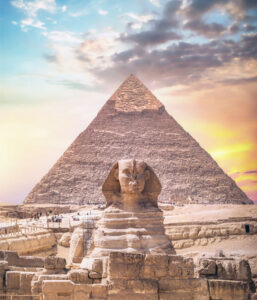The Great Pyramid of Khufu, also known as the Pyramid of Cheops, is the largest and most famous of the pyramids on the Giza Plateau. Constructed during the Fourth Dynasty around 2580–2560 BC, this pyramid was built as a tomb for the Pharaoh Khufu and remains one of the most remarkable architectural feats of the ancient world.
Originally standing at 146.6 meters (481 feet), the Great Pyramid was the tallest man-made structure in the world for over 3,800 years. It was constructed using approximately 2.3 million limestone blocks, each weighing an average of 2.5 tons. The pyramid’s precise alignment with the cardinal points and its intricate internal chambers reflect the advanced engineering skills of ancient Egyptian builders.
The Great Pyramid was part of a larger complex that included smaller pyramids for Khufu’s queens, a mortuary temple, and boat pits. Despite its massive size and grandeur, the interior of the pyramid is relatively sparse, with the King’s Chamber, Queen’s Chamber, and Grand Gallery being the most notable features.
As the only surviving wonder of the Seven Wonders of the Ancient World, the Great Pyramid of Khufu continues to attract millions of visitors each year. It stands as a symbol of ancient Egyptian civilization and is a focal point for ongoing research into the techniques and purposes behind pyramid construction.
